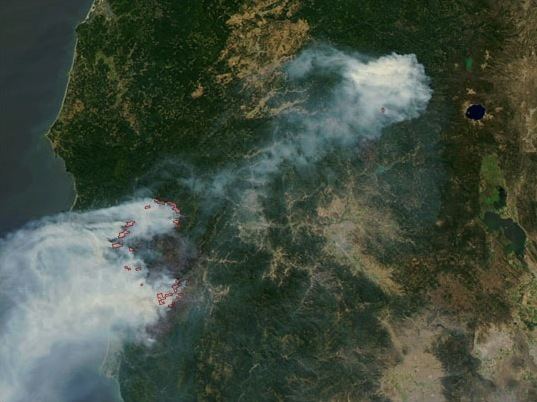Cause Lightning | ||
 | ||
Location Siskiyou National Forest, Oregon and California, USA Date(s) July 12, 2002 (2002-07-12)–
July 15, 2002 (2002-07-15) Burned area 500,000 acres (2,000 km) Land use Mixed, residential and wildlands | ||
The Biscuit Fire was a wildfire that took place in 2002 that burned nearly 500,000 acres (780 sq mi; 2,000 km2) in the Siskiyou National Forest in southern Oregon and northern California, in the Western United States. The fire was named after Biscuit Creek in southern Oregon.
Contents
Siskiyou wildfires
The fire season in 2002 was an especially active one that started early with major fires in Arizona, Colorado, and New Mexico, pulling resources from the Pacific Northwest. Between July 12 and July 15, a series of lightning storms occurred in California and Oregon starting hundreds of small wildfires. During this period, five such fires were started within a 20-mile (32 km) radius of each other near the state border. Due to the fires already burning in other areas, insufficient numbers of fire crews and smokejumpers were available to combat these fires and they began to burn out of control. The large Florence Fire, which had started approximately 30 miles (48 km) north of the border, eventually joined what was known as the Sour Biscuit Fire, which was burning very close to the border. Once the massive Biscuit Fire was created, it could not be fully contained until December 31, 2002.
Damages
The fire destroyed 4 primary residences and 10 other structures, put 15,000 residents on evacuation notice and burned most of the 180,000-acre (730 km2) Kalmiopsis Wilderness. Despite the level of destruction, there were no deaths attributed to the fire.
Post-wildfire
Since the fire, the United States Forest Service has been trying to log most of the severely burnt area, despite ecologists' concerns about the Port Orford Cedar, which is threatened from a root fungus that is most commonly spread on car tires and shoes. This will be the largest recorded timber sale in U.S. history, and a landmark case setting the future for all fires in national forests. The cost of salvage logging far outweighed the proceeds from sales (-$1.9 million).
In 2006, a research paper on the effects of post-wildfire salvage logging caused a controversy within the forest sciences community.
